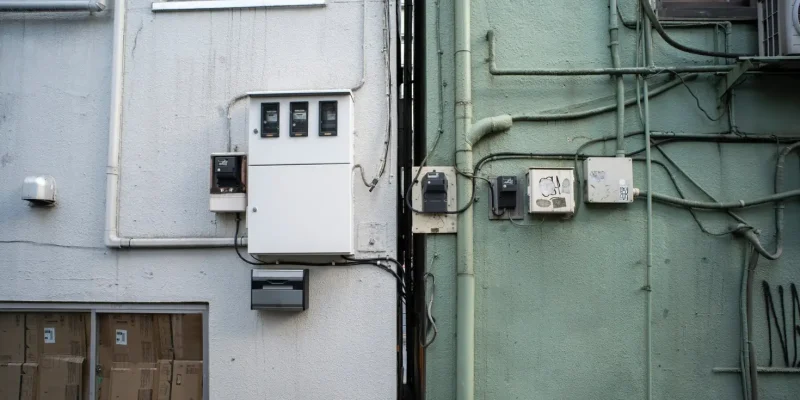IMPORTANT SAFETY NOTE: Electrical work should only be performed by qualified and licensed professionals. This article is for informational purposes only. Working with electricity can be fatal if proper precautions aren’t taken.
Ever wonder how electricity safely makes its way from the power grid to your kitchen toaster? Let’s take a journey through your home’s electrical system, focusing on the unsung hero of household power: the main service panel.
From Grid to Home
The path of electricity to your home starts with distribution cables carrying high voltage power. This voltage is stepped down through transformers (usually mounted on poles) to a level suitable for residential use. Before entering your home, electricity passes through a meter that tracks your usage for billing purposes.
The Brain of Your Home’s Electrical System
The main service panel – sometimes called a load center or breaker box – is essentially your home’s electrical command center. Inside this modest metal box lies a sophisticated system of components working together to deliver power safely throughout your home.
Key Components:
- Main Breaker
- Usually located at the top of the panel
- Controls power to the entire house
- Typically rated for 100-200 amps
- Can be manually switched off in emergencies
- Bus Bars
- Two “hot” bars carrying 120V each
- Together provide 240V for larger appliances
- Connected directly to the main breaker
- Neutral and Ground Bus Bars
- Provide return path for electrical current
- Essential for safety and proper circuit completion
- Connected to ground rod outside the house
Circuit Breakers: Your Safety Guardians
Modern circuit breakers are marvels of safety engineering, offering multiple layers of protection:
Standard Circuit Breakers
- Control individual circuits
- Provide overload protection
- Respond to short circuits
- Can be manually switched off
Special Protection Breakers
- GFCI (Ground Fault Circuit Interrupter)
- Required in wet areas like kitchens and bathrooms
- Monitors current flow discrepancies
- Can prevent fatal electric shocks
- Trips when it detects current leakage
- AFCI (Arc Fault Circuit Interrupter)
- Required in bedrooms and living spaces
- Detects dangerous electrical arcing
- Helps prevent electrical fires
- Monitors circuit patterns for abnormalities
Understanding Voltage
Your home’s electrical system provides two voltage levels:
- 120V circuits for general use (lights, outlets)
- 240V circuits for large appliances (dryer, AC unit)
This dual-voltage system is achieved through clever transformer wiring, with the two hot bus bars each providing 120V relative to neutral, or 240V when used together.
Safety Features You Should Know About
Your electrical system includes several critical safety features:
- Grounding System
- Copper wire connected to ground rod
- Protects against lightning strikes
- Provides path for fault currents
- Bonding System
- Connects metal piping to electrical ground
- Prevents shock hazards from damaged wiring
- Creates safe path for fault current
- Multiple Disconnect Options
- Main breaker for whole-house shutdown
- Individual breakers for circuit control
- Quick access in emergencies
What Homeowners Should Know
While electrical work should be left to professionals, understanding your electrical system helps you:
- Identify potential problems before they become dangerous
- Know when to call an electrician
- Understand the importance of proper maintenance
- Make informed decisions about electrical upgrades
Remember: Your electrical panel is sophisticated safety equipment, not just a box of switches. If you notice any usual sounds, smells, or behavior from your electrical system, contact a licensed electrician immediately.
Looking Forward
With the rise of new technologies such as EV chargers and solar systems, understanding the basics of your home’s electrical system is more important than ever. Your main service panel might appear straightforward, but it plays a critical role in ensuring your home receives power safely and efficiently.
Next time you turn on a light or plug in a device, remember the intricate system behind your walls working to supply power safely. Maintaining and respecting this essential system is vital for your safety and the proper functioning of your home.


